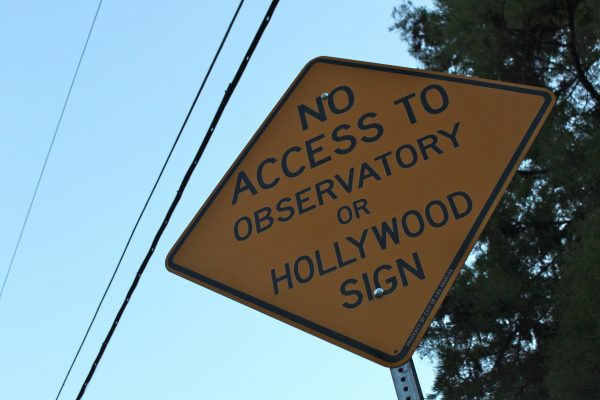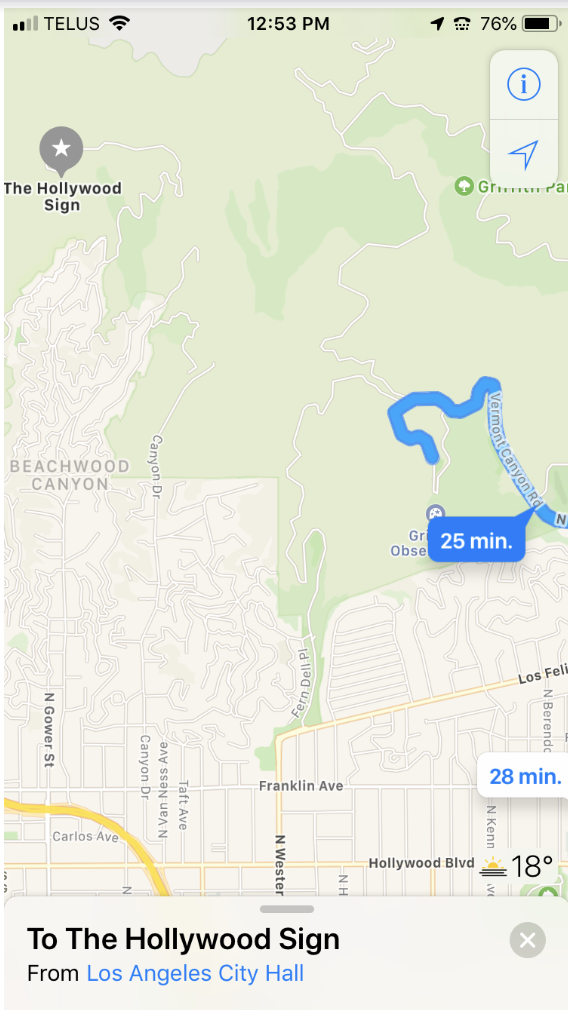The Hollywood Sign by Chris Berube
Since it was built in the 1920s as a real estate ad, the Hollywood sign has become an icon. Despite some hard years – Hugh Hefner actually spent hundreds of thousands of dollars to get it refurbished and saved from developers — the sign has become a symbol of American culture worldwide, and a magnet drawing tourists every day.

But there’s one big problem with the sign as a tourist destination – it’s hard to get to. The sign is perched on Mount Lee, in Griffith Park, and there’s no way to drive up to it. For years, tourists would settle for a distant view of the sign. But after the rise of GPS, tourists began parking in residential neighborhoods nearby and hiking up. Some residents of Beachwood Canyon – a neighborhood under the sign that connects to the Hollyridge Trail – have complained for years to city council about the glut of tourists causing noise and congestion. “You had groups of people, thirty to fifty people, walking in the street with no sidewalk,” says Sarahjane Schwartz, the former leader of a homeowners’ association who now advocates full-time for less tourist activity in her neighborhood. She says her biggest concern is fires since tourists often leave cigarette butts on the street.
Some residents of Beachwood Canyon have lobbied politicians on this issue, while others have engaged in activities like painting the curbs to discourage parking, and using informal signage to scare off tourists, with messages like “There is no access here to the Hollywood sign.”

In the early 2010s, some homeowners and the area’s city councillor even convinced Google, Apple, and other digital mapmakers to give a different location for the sign. Today, if you ask for driving instructions to “the Hollywood sign” on one of those apps, they direct you to the Griffith Observatory, which has a view of the Hollywood sign but is miles away.

Meanwhile, if you ask for directions from the Griffith Observatory to the sign, it directs you to drive in a circle.

These kinds of activities have made many urbanists uneasy, and have spurred editorials calling these residents NIMBYS who are fighting to limit access to public space. (However, Schwartz and others have argued they are mostly concerned about safety.) Recently, the Hollyridge Trailhead in Beachwood Canyon was closed off to tourists, and other proposals have been made, from building a second Hollywood sign, to building a tram that would take tourists directly up to the sign, bypassing the neighborhoods below.
Special thanks to Gordon Douglas, author of “The Help Yourself City”



Comments (20)
Share
The hsbc hq in HK was designed and constructed (1983) before the Bank of China building was constructed in 1985. It’s true that Foster and Partners consulted fung shui experts, but that was a matter of course because they were constructing in HK and it was going to be an important landmark.
To clarify: the construction of the two buildings actually overlapped (one was completed in late 1985, the other started earlier that year). That said, it is true that the HSBC building was started before the Bank of China building, though the cranes mentioned were added to the HSBC indeed were (as far as I can tell from my research) designed to address the poor feng shui of the BoC building – I am not sure if they were added later or during the overlapping construction period. Source: https://archive.nytimes.com/www.nytimes.com/fodors/top/features/travel/destinations/asia/china/hongkong/fdrs_feat_74_10.html?n=Top%25252 -= Kurt
I love this show. I love this episode, I appreciate all of you that work on it: Please don’t use the word spirit animal if you are not a member of an indigenous community. If you are I’m sorry for butting in but heads up.
This is the same thing I came over here to comment on. Great show, lovely intent. However, it’s about time we abolished “spirit animal” from the general lexicon. There are other options for inferring the same intended meaning without intruding on or mocking marginalized people.
There is no mocking or intruding context here.
I believe the television program mentioned in the Raccoon story was a 2012 episode of the PBS program, Nature, called “Raccoon Nation.” It’s online at: https://www.pbs.org/wnet/nature/raccoon-nation-introduction/7518/
It mentions the problems Japanese temples have had with Raccoons along with lots of other fascinating information about these amazing creatures.
at the top of beechwood canyon, below the hollywood sign, there is also a high fence with a gate. above the gate is a camera surrounded by a ring of red lights. it is terrifying. it looks straight of some orwellian police state. the gate has a proximity sensor and makes a very aggressive sounding tone (not a beep but a sustained tone) as you approach it
Hi!
Thank you for all the beautiful episodes.
Here is one more example of such architecture inspired by Rudolph Steiner and anthroposophy (even though I’m not a fan of that esotericism):
https://www.designboom.com/architecture/rudolf-steiners-goetheanum-anthroposophical-expressionist-concrete-architecture-gesamtkunstwerk-06-21-2019/
You might remember the tanooki suit from Super Mario 3 video game.
https://www.mariowiki.com/Tanooki_Suit
About the Hollywood Sign Access. I think I’m with the residents on this. At least it sounds like that while the sign is public, there isn’t (good) public infrastructure to hike to it. As part of that public going through the neighborhood isn’t treating the neighborhood nice nor does they city police/clean/maintain the neighborhood. I’d do my best to keep my property nice.
I live in Centretown and have a correction to make to the Jack Purcell story. They aren’t lamp posts at all, they’re just sculptures. After some research I found a rendering that shows the light coming through the holes that would’ve held the string, which would be post-redesign but pre-implementation. I think this was an attempt to make the ‘trees’ a little more exciting, but wasn’t feasible since they were never designed to be lights. Now we have brutalist quidditch rings and a story.
Hey I did the hike! Didn’t even know there’s instructions. I came on a bus to the eara near (not even the park, but the other side!) by and just started walking not knowing it’ll be such a winding complex walk throgh all these houses. Ended up walking about an hour on a very hot day and feeling sorry for the residents having tons of people like me come by.
Two comments about the rampaging raccoons: First, are there reasons TNR (trap, neuter & release) wouldn’t work to control the population? That would take away the Buddhists having to kill a living creature issue. Second & on a happier note: did you notice that the theme song for “Araiguma Rascal” is the first tune in the classic arcade game Frogger? :D
I live in Boston and use mass transit to get everywhere. I don’t even own an automobile. I used Apple Maps and typed in The Hollywood Sign for directions using transit. Amtrak to San Bernardino, Metrolink SB line to Union Station, then choice of AV Line or Red Line to two different bus lines that get you within 25-35 minute walk to the sign. The walk is likely through the neighborhood mentioned in the story. I used to date a woman from LA and would go out ther for Christmas. The first time I was told the only way to get to the family house in an east of LA suburb near Corona was by airport limo/van. Very expensive and took forever. After that I figured out a way to get within a 20 minute drive of the house using bus and Metrolink. Easy!
I find the story about raccoon particularly fascinating. The effect of animated series “Rascal Raccoon” on the population surge of Alien Raccoon has apparently been acknowledged in a study:
https://www.researchgate.net/publication/228486361_Present_status_of_invasive_alien_raccoon_and_its_impact_in_Japan
Also somewhat related to the topic:
https://journals.plos.org/plosone/article?id=10.1371/journal.pone.0106565
I love your show, keep up the great work!
Just listening to the witch window story and you solved the blue paint in chefchawan Morocco. Our guide did say the paint was a mosquito repellent:)
The most obvious superstitious influence on architecture that I see is the omission of the 13th floor. My ER doesn’t have a room 13.
So interestingly in the United States the European Starling and the House Sparrow are exotic invasives because of a persons love of literature namely Shakespeare.
Pikachu is based of the Northern pika (Ochotona hyperborea) though I kinda think it looks more like the American pika (Ochotona prince’s)
Thanks for the mini-stories, I love them (and you guys)! The raccoon story reminded me of another one by Radiolab (Stranger in Paradise), about how raccoons came to Guadeloupe.
Also when I was a kid in Hawaii in the 60s, there was a popular song about raccoons. This cartoon is how I remember it – https://www.youtube.com/watch?v=FeMaFJsvm9w. I did a little searching and discovered this song is about the native Japanese raccoon dog, not the interloper – Shojoji no tanuki bayashi (Raccoon Dogs Dancing at Shojoji Temple.
I had Mickey Mouse Club LP album from the 1950s, when I was a kid, with a Japanese song and an English verse translation. I thought of digging it out to record that to share with you, but I found a close version online:
https://www.youtube.com/watch?v=QxDVcI4HHRk
The English verse on the album I have is
Sho, sho, sho jo ji; Sho jo ji is a raccoon
He is always hungry, so he sings of koi koi koi
We used to sing along, as closely as we could hear it. My sister sang it for a Japanese friend at college, and he said we had most of it right.
According to the intro on the 45 in the video, the song went with a kids’ circle dance.
So there was already some interest in raccoons, among Japanese children, in or before the mid-1950s.